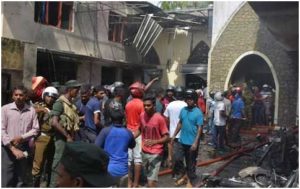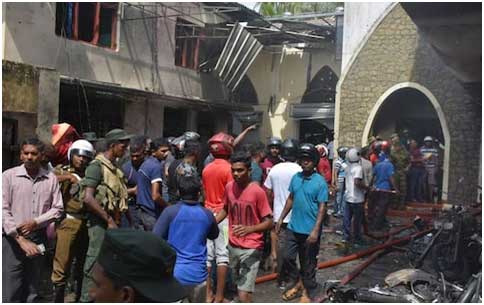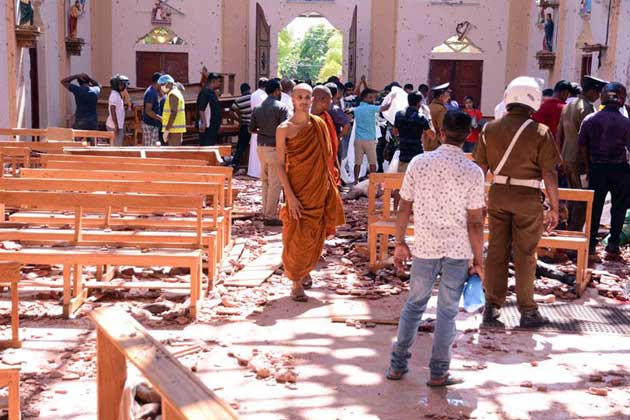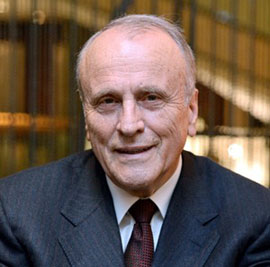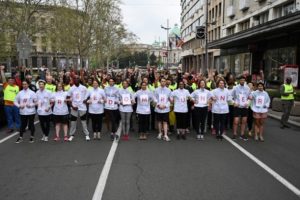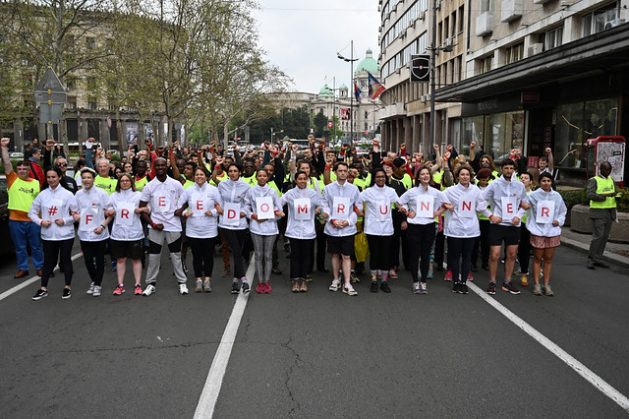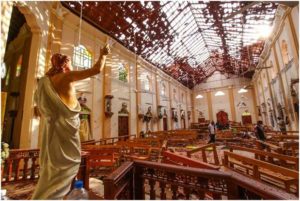
Armed Conflicts, Asia-Pacific, Civil Society, Featured, Global, Global Governance, Headlines, Human Rights, IPS UN: Inside the Glasshouse, Peace, TerraViva United Nations
H.L.D. Mahindapala is a Sri Lankan journalist who was Editor, Sunday Observer (1990-1994), President, Sri Lanka Working Journalists’ Association (1991-1993) and Secretary-General, South Asia Media Association (1994).
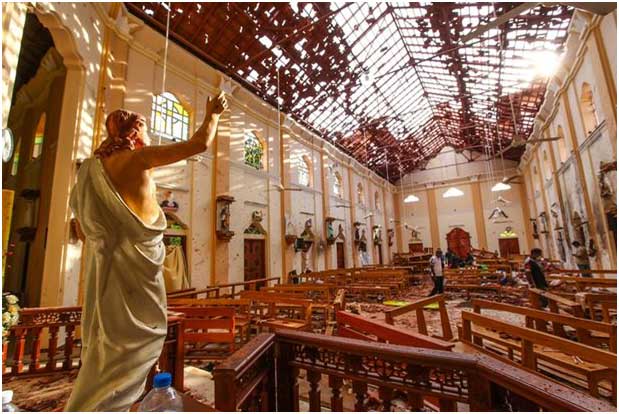
– The history of terrorism in Sri Lanka reveals a clear pattern. The first to take up arms in the post-Independent era were the misguided Sinhala youth. They were educated youth desperately running in search of a quick solution to establish their classless paradise. Their violence did not take them anywhere.
The Tamil youth were the second to take up arms. Most of their cadres too consisted of educated Tamil youth running in search of a speedy route to establish their mono-ethnic paradise. At the end of a three-decade war they sank to the bottom of the Nandikadal Lagoon.
Now the Muslim youth have bombed their way into the global headlines. They shot into the limelight on the morning of Easter Sunday taking everyone by surprise. Unlike the two preceding terrorist groups the local Muslim terrorists who carried backpacks loaded with explosives seems to be dummies carrying out the orders and agenda of a hidden hand directing them from abroad.
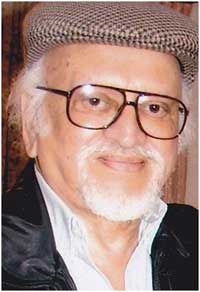
H.L.D. Mahindapala
To begin with they were echoing the imported hate politics fed to them by the extremist local agents running fragmented jihadist cells. Nor have they produced a calculated, well-defined ideology against the state, like the other two terrorist organisations, arguing that it should be destroyed and replaced with their political models.
However, it is known that the preachers in their cells and madrassas have been indoctrinating the youth with violent interpretations of the Koran with the aim of converting Sri Lanka into an Islamic Caliphate. That constitutes a part of the larger agenda of ISIS, without any local content in it.
Running through all three violent movements of the youth is a manufactured ideology tailored to radicalise and convert them into violent politics as the solution to their indoctrinated, imagined and real problems.
The Sinhala youth took to Marxists revolutionary ideology reduced to five lectures. The Tamil youth took to the ideology of the Saivite Jaffna Vellala supremacists to create Eelam – the paradise of mono-ethnic extremism. And the Muslim youth seems to have jumped into a similar ideology believing that they could achieve their Islamic salvation at the end of violence.
If history is any guide then the preceding two violent movements point to a bitter end. Like the other two preceding terrorist groups the Muslim terrorists too are doomed to end up achieving nothing. Besides, the odds are tilted heavily against the Muslim terrorists, both internationally and locally.
They have begun with a big bang which had echoed round the world. That is about all they could achieve: making big noises if they are to continue down this path of violence. Whether they have the capacity to sustain the violence of the Easter Massacre on a mass scale for a prolong period is questionable.
Based more on the historical evidence of the past two youth revolts than on the skimpy details available on the Muslim youth, my conclusion is quite simple: neither the prevailing hostile international climate against every kind of Muslim violence, nor the national ethos of a thriving and conservative Muslim trading community dependent on peace and stability, is conducive for the Muslim youth to sustain their campaign of violence for long.
Besides the wobbly Yahapalanaya Sri Lankan government, which was going softly– softly on rising Muslim radicalisation and violence– has at last woken up to the grim and destabilising realities that had blown their tops off. It is the magnitude of the simultaneous explosions hitting three points of the compass – east, west and the immediate north – that shook the foundations of Sri Lankan establishment
The Easter Sunday blast is likely to change – at least in the short run — the conventional image of the Muslims. They were seen as the more emancipated and liberal Muslims not committed to radical Islam. But after the East Sunday Massacre it is likely that they will be bundled with the rest of the ideologically driven Muslim fanatics abroad committed to irrational violence.
The latest Reuter’s report which reveals the ISIS hand behind the Easter Massacre can only reinforce the image of being ruthless religious fanatics.
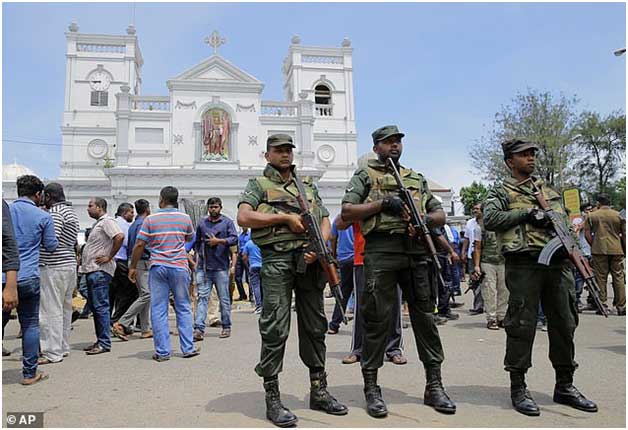
Radicalisation takes sense and sensibility out of the minds of the impatient youth looking for instant solutions. And politicised religion is packed with hate. Both are incendiary forces that can drive the impulsive youth into insane fits of violence.
Of course, the initial blast that shook Easter Sunday was massive and impressive. The (1) precision timing that went off like clockwork, (2) the gigantic scale of the blasts hitting targets in east, west and the near north simultaneously,(3) the selected targets of Christian Churches and hotels packed with Western tourists (4) the organisation capacity to piece together the various arms of the military-style operation that exploded on Easter Sunday (5) the blind faith of the suicide bombers that walked the lethal distance to their fatal end and that of 350 other victims, point clearly to hidden brains beyond the borders of the local Muslims.
There is, no doubt, that the suicide bombers were on a political mission. But what was it? Also, terrorist acts are executed to convey a political message. What is the message behind the biggest ever terrorist operation on Sri Lanka soil?
This explosion which hit like a bolt from the blue makes no sense in the Sri Lankan context. Apart from sporadic tensions – some of which have been caused by National Thowheeth Jamaat (NTJ) – the Sinhala-Muslim relations had not stretched to breaking point to provoke an attack of this magnitude.
Mainstream Muslim politics was for co-existence without resorting to extremist violence. Interventions at the highest levels from both sides have succeeded in snuffing out any communal conflagration and containing the violence.
In fact, Muslim leaders have been complaining to the authorities that the NTJ is a serious threat to their lives too. Nor has there been a mass following for Islamic extremism either at the top or at the bottom layers of Muslim society.
As of now Muslim violence has been confined to a minority. But it is a minority that has crept up, sedulously and surreptitiously, to parts of the higher layers of the Muslim hierarchy. If allowed to go unchecked it can become the majority.
The description of this group given by Ruwan Wijewardene, State Minister of Defence, is revealing and alarming, to say the least. He said: “What I can also say about this group of suicide bombers is that most of them were well-educated and come from middle or upper middle class, so they are financially independent and their families are quite stable financially. That is a worrying factor in this. Some of them studied in other countries, they hold degrees and were quite well-educated people.”
This explains the background and the potential threat to the future but not the cause behind the stunning Easter Sunday massacre. Invariably political protests and violence target the state. But the Muslim suicide bombers did not target the state per se.
They went straight to two non-state, non-Sinhala-Buddhist targets: 1. Christian churches packed with Easter Sunday devotees and 2. hotels packed with Western holiday-makers lining up for their Sunday breakfast. Both targets were selected to make global headlines in the Christian West.
Any harm to the Christian worshippers inside churches in one of the holiest days in the Christian calendar and Western holiday-makers would instinctively tug the heart strings and the conscience of the West.
It is the selection of these two targets that do not make sense. Why should local suicide bombers target the Churches and the hotels when their grievances are supposed to be against the Sinhala-Buddhists with whom they have been having some sporadic sparring in recent times?
Besides, none of these two institutions has rubbed against the local Muslims. So why did the strategists behind Operation Easter Massacre target the Churches and the hotels? Isn’t the message coded in these two targets?
It is at this point that Ruwan Wijewardene’s explanation gains credibility. He said that the targets were chosen as retaliation for the massacre of the Muslims at Christchurch by the Australian white-supremacist Brenton Hanson Terrant. But is the local Muslim that concerned about what happened in far-away New Zealand to blow up Churches and hotels? No.
But the vindictive politics of their masters in the failed Islamic State, pursuing anti-American, anti-Christian agenda, are bent on targeting the sacred symbols of the West. Since the Sri Lankan Muslims are committed ideologically to follow the political line laid down by their Islamic masters abroad, they became the latest suicidal messengers of death to the West. They even went as far as imitating their counterparts abroad by videoing their martyrdom, a la the jihadists in the Middle East.
Second, the Easter Massacre was to deliver a political message to Donald Trump. He was boasting that the ISIS is dead. On the morning of Easter Sunday, they told him that they are still alive and kicking. The ideology behind the Easter Massacre is clearly expressed in the two main targets allied to Western interests. It also contains a direct message to Trumpian braggadocio and arrogance.
They picked Sri Lanka because it was fast turning into a base for American expansion in the Indian Ocean. The signals radiated by the bombs have already hit the American radar. They have now cancelled the joint naval exercises scheduled to be held in the east.
Like all terrorists they have picked the most iconic targets for maximum impact in the minds of the West. Targeting them selectively on one of the holiest days of the Christian world delivers an unambiguous political message to the West saying: If we can’t get you in the West we can get you in soft spots prepared by incompetent, complacent and back-biting rulers in the East who, incidentally, are cozying up to the West.
The tattered remnants standing as sad ruins of churches and hotels and the 350 victims debunk the usual fiction spun by some local political pundits who continue to blame the Sinhala-Buddhists. Their spin is to white-wash the Muslim terrorists saying that the suicide bombers were on a mission to get even with the Sinhala-Buddhists for sporadic attacks that had occurred in recent time.
This line of attack on the Sinhala-Buddhist runs against the evidence of the bloody ruins staring in their face. If the Easter Massacre was to teach the Sinhala-Buddhist a lesson why did they attack the Christian Churches and hotels packed with Westerners? This is the most notable facet of the Easter Sunday attack.
The suicide bombers skipped the Sinhala-Buddhists, they skipped the Hindu Tamils and they went straight for the Christians in churches and the Westerners holidaying in hotels.
If the Easter Sunday massacre was to send a clear message to the West then the international and local agents have succeeded beyond their expectations. This initial message is now reverberating globally. It says un-mistakeably that the Jihadist power, packed with religious fanaticism, has found a new base to attack the West. But what is going to be their next step? Will they turn inward and intensify their attacks against the other religionists?
Violence of any sort will not take the Muslim terrorist anywhere. If the other two varieties of terrorism (Sinhala and Tamil youth) failed to win against the state what are the chances of the Muslim variety winning?
The state is sufficiently prepared and experienced now to meet challenges of terrorists having beaten the world’s deadliest terrorist, the LTTE. Most of all, it has the tacit support of the majority of the Muslims in the mainstream.
ISIS and its local agents have had some beginners luck by taking the state by surprise. But the chances of Muslim terrorists becoming a formidable challenge to the state are very remote. Besides, before they take on the state they will have to grab power from the established Muslim hierarchy. They will also have to combat the anti-Muslim counter-terror forces of the West and also India.
The upshot of the Easter Massacre has been to increase and reinforce Islamophobia. Until Easter Sunday the Muslims in the democratic mainstream have been a formidable force negotiating craftily behind the scene, with both main parties, bargaining with the non-violent votes.
But the exploding bombs have devastated their image and reduced the power of bargaining with both major parties. They cannot be seen to be honeymooning, or playing footsy with the Muslims after the backlash of Easter Sunday sweeping the nation. The government, in particular, will have to face the charge of putting Bodu Bala Sena in jail and letting NTJ run amok without any restraint.
The state is now in a favourable political climate to crack down on Muslim extremism with hardly any pressure from international or national interventionists. Besides, the Muslim terrorists can never reach the militarised power of the Tamil Tigers and challenge the state to yield to their demands, whatever they may be. Of the three varieties of terrorism the Muslims will be the weakest, purely on demographic counts.
When the dust settles down, the democratic state of Sri Lanka will rise again triumphantly, hoping that the last remaining Indian Tamil youth will not decide to go the way of the other three failed terrorists

